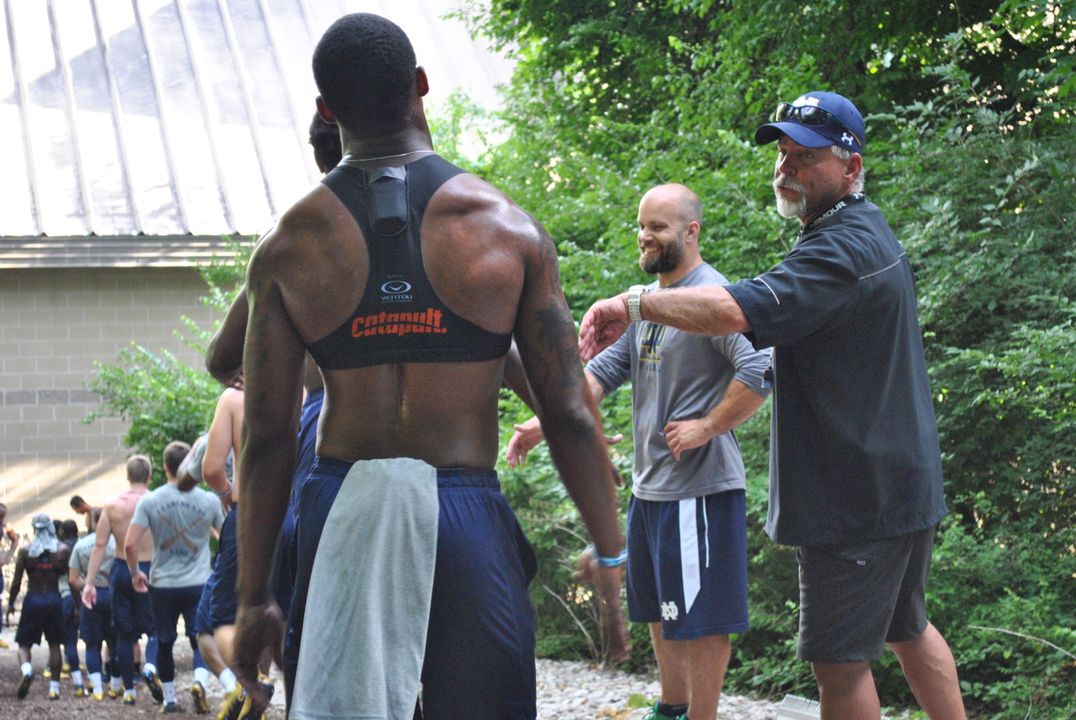Sept. 17, 2016
By John Heisler
Dr. Duncan French’s name will not appear in the box score of tonight’s football game between the University of Notre Dame and Michigan State University.
He did not account for any saves or kills in last night’s Irish men’s and women’s soccer or volleyball action.
Though French is an accomplished surfer, he’s not likely to put those skills to use often in South Bend.
Check in, however, with Notre Dame vice president and James E. Rohr director of athletics Jack Swarbrick and senior associate athletics director for student-athlete services Mike Harrity—and Irish head coaches—and they’ll all suggest French has the potential to be as crucial a long-term contributor to the success of Notre Dame athletics as anyone who makes a tackle or swims a lap.
French came on board in January as director of performance sciences for Notre Dame athletics. He works across all sports to provide a technical interface between coaches and support services, as well as coordinating the sports science initiatives that support competitive advantage.
Think of him as one of those old-fashioned, country physicians. He has the ability to go door to door with the 26 Irish sports and use his bag of tools to help keep all those athletes and programs running smoothly, if not even more efficiently than that.
As Swarbrick reinforces any time he speaks about Irish athletics priorities, one of Notre Dame’s primary objectives is to support and improve athletic performance through the application of science, medicine and technology. Central to this is a philosophy that works to create systems and structures to maximize the impact of technical expertise, environments, technology and service delivery on an athlete’s ability to optimize performance. All Notre Dame sports performance staff members are empowered to gain insights through athlete monitoring and profiling that allow implementation of positive interventions.
“Our primary ambition within the sports performance division is to create performance structures that parallel the specific needs of each sport,” says French. “To do this our mission is to provide an integrated, multi-disciplinary environment, aligned to ‘what it takes to win,’ allowing student-athletes to excel. By working more strategically to create a bespoke approach to service delivery, we are better able to align the support services of strength and conditioning, high performance lifestyles (student welfare and development), nutrition, athletics training and mental conditioning, such that our contributions serve to support all aspects of the practice/compete/recover process.”
Harrity recognizes the fun challenge such a bold vision poses.
“Our promise to all of our prospective student-athletes is that we will help them maximize their growth intellectually, athletically and personally,” says Harrity, who in 2013 was appointed by Swarbrick to lead the newly-united student-athlete services team that includes leadership and career development programming, strength and conditioning, community service, sports science, athletic training, medical services, mental conditioning and nutrition. “The commitment they make by coming to Notre Dame is that they’ll invest themselves fully in that opportunity for growth. To deliver on our promise, it is absolutely necessary to connect and build trusting relationships with them, which is only possible if we understand who they are and who they aspire to be.
“Once we understand each of our 740 student-athletes as individuals, we can design a specific program that will help maximize their overall potential,” Harrity adds. “That’s an audacious goal, and we embrace that–our staff is filled with people who are energized by the opportunity. To accomplish it, we need one vision. How do we help the athletic trainer, nutritionist, leadership development team and everyone else who is focused on this goal all see the larger picture and speak the same language, which supports the ‘what it takes to win’ philosophy for a respective team? We need clarity in the message and consistency in aligning our efforts to support the one vision for each student-athlete. That’s why we imagined the director of performance sciences role. And Duncan is the perfect person to lead the charge.”
While many of these support service areas—such as athletic training and strength and conditioning—have been in place for decades, even those programs have more sophisticated tools, methods and technology at their disposal.
French is charged with coordinating all the support services to best help Irish sports programs achieve. He begins by undertaking a performance modeling process for each sport. French then works with the individual support services to create a game plan that features development and improvement of team members in specific ways that support each coach’s plan to win.
“The concept of performance modeling is central to the success of the many Olympic and professional programs,” says French. “Fundamental to performance modeling is a strategic approach to answering the question, ‘What does it take to win?’ Clearly defined parameters set forth by the coaches essentially direct the distribution of resources, innovation and technical expertise to better align with this philosophy.
“We start by looking at the demands of the event involved—whether it’s a racing event, a combat event, a team sport or a judged sport. Next we undertake a gap analysis and profile that team’s athletes, its full roster, against those demands. Next come objectives and goal-setting. Finally, we develop a performance plan for all the support service functions to address that gap analysis. As the season goes on, we will monitor progress and audit the program at the end of the year.
“The key question is, ‘How are we going to increase our potential to succeed?’ That’s what the performance modeling process is all about. It’s about understanding how we can achieve success. We have offensive systems, defensive systems, player development systems, and now we have a system to more effectively align our support services. It’s a very strategic approach to try to influence success. It’s a proven, coach-driven, athlete-centered model, and it has to be pollinated and owned by them. The coaches are part owners of this process as well as being consumers along with the athletes.
“We need to enhance our delivery of these various services to match the individual specific needs of each sport. What need to ask ourselves what are the best practices globally in hockey, baseball or track and field? We are trying to eliminate the guesswork.
“The coaches are the ones who know how their teams can best be successful. They know what it takes to win. They know what they believe their style of play needs to be.”
French provides an example of addressing the gap analysis.
“Let’s be very specific. Let’s say that in soccer we want more shots per game, more final third entries and we want our wingers sprinting harder and more often to accomplish that. That’s a physiological aspect that our strength and conditioning staff can address. But you also may need to include a hamstring prevention program if those wingers are going to be sprinting harder and longer and more often. There’s your headline goal with some technical specifics to make it happen. Then you look at the metrics to determine if you are making progress toward that goal—that’s addressing the gap. By addressing these needs, our support services can then demonstrate the valuable impact that they have in contributing to the success of the team.”
As the 2016-17 academic year began, French and his fellow directors of student-athlete support units offered a variety of programming for Irish teams:
–Personal Growth Seminars (required of all teams)—a one-hour session titled, “Values-based decision-making: Setting goals and making the most of your time,” led by student welfare and development staff.
–First-Year Parent Welcome during orientation weekend, including messaging from director of mental conditioning Derin McMains about how parents can support first-year student-athletes.
–Performance Orientation Day (for all teams except fall sports)—featuring a host of screening and assessment activities to collect data that will help performance staff optimally support each sport program. On the day before classes began, each team devoted four hours to various programs and testing in the areas of compliance, concussion education, concussion baseline, physical examinations, athlete functional movement/injury prevention screening, plus a presentation titled, “Healthy Relationships,” led by director of student welfare and development Claire VeNard, director of the Gender Relations Center Christine Caron Gebhardt and her staff, alongside other key campus partners.
–First Year Student-Athlete Welcome—a peer-led speed networking session answering transition questions and providing tips for success as a Notre Dame student-athlete.
–Details on Notre Dame’s Student-Athlete Advisory Council (SAAC), Rosenthal Leadership Academy, Notre Dame Christian Athletes and career fairs.
Says French, “When I think of high performance lifestyles I think of a boat going through a rocky sea. If the boat has a real strong keel through a rocky sea of performance, you don’t see the keel because it’s under the water. But because of the keel the boat can go smoothly on a straight path through those rocky seas. If you take away that keel the boat will be rocking and rolling and it won’t be going over the path we want to in the most efficient way. That’s how high performance lifestyles can help support student athletes stay on the right track as they juggle academics with all the things that go into practice, competition and the rest of their pursuits.”
French brings with him over 15 years of experience working with elite professionals and Olympic sports. Prior to arriving at Notre Dame, French was a technical lead for strength and conditioning at the English Institute of Sport. He has worked three full Olympic cycles and has been the national lead for strength and conditioning for both Great Britain’s taekwondo and basketball Olympics programs.
As a strength and conditioning coach, French has coached a host of Olympic, World Championship and Commonwealth medalists from a variety of different sports disciplines. For three seasons from 2009-12, French also served as the head of strength and conditioning at the Newcastle United Football Club, playing in the Barclays English Premier League.
French earned his PhD in exercise physiology from the University of Connecticut in 2004. His research interests lay in neuroendocrine responses to resistance training, strength diagnostics, muscle physiology and the mechanisms of recovery and regeneration. French has authored or coauthored over 55 peer-reviewed scientific manuscripts and six book chapters.
In 2010 he was the recipient of the Terry J. Housh Outstanding Young Investigator of the Year Award from the National Strength & Conditioning Association. He currently serves as an editorial board member for the Journal of Strength & Conditioning Research and the International Journal of Sports Physiology and Performance. He is a fully-accredited strength and conditioning coach with the United Kingdom Strength and Conditioning Association (UKSCA), Australian Strength and Conditioning Association (ASCA) and the National Strength and Conditioning Association (NSCA) of America and holds USA weightlifting certification. A board member since 2008, French was the chairman of the UKSCA from 2011-13.
Before surfing, French played soccer to a high junior level and went on to play American football for the British national teams at junior, collegiate and senior international levels as a running back. French and his wife, Katie, moved from his hometown of Newcastle upon Tyne in the United Kingdom.
Within the variety of student service divisions that French serves, here are details of specific initiatives that Notre Dame’s sport performance program utilizes:
–CoachMePlus is an app-based platform now providing the sports performance staff and coaches with the opportunity to centralize collected data. The system enables athletes to report data on a daily or scheduled basis as well as providing the opportunity to visualize and report that information to sports performance team members, coaches and athletes.
–Sleep monitoring and research with the Sleep, Stress and Memory Lab on campus produces specific research as it pertains to athletes and their athletic performance.
–Force plate assessments enable profiles of athletes as it pertains to their physical abilities, trainability and fatigue. The long-term goal is to be able to profile athletes on the plate to understand how they compare to previous/other current athletes, how a training intervention has impacted their physical qualities—and how fatigue is impacting their ability to perform. Through ongoing conversations with departments on campus (including computer engineering) algorithm will assist in providing additional usable information in these areas. Strength and conditioning coach Geoff Puls partnered on a successful grant application with University professor Dr. Patrick Flynn from the computer science and engineering department to explore bespoke force-plate applications within the weight room setting.
–Matt Howley, director of sports science, coordinates the use of Catapult (GPS), providing objective external load data. Used across seven teams, including football, it provides an understanding of each sport and physical demands required of it, then linking those details to practice plans. The aim is to assist coaches in planning practice sessions, to ensure optimal performance in games, and to enable appropriate levels of training stress to be applied to athletes. Catapult also monitors physical performance to understand if an athlete may become overtrained or is undertraining. It assists in return-to-play protocols ensuring athletes are where they need to be prior to returning from injury—and it makes interventions to decrease the risk of injury.
–Fusionetics provides specific interventions for each athlete based on screenings in which the created intervention is designed to help create symmetry for athletes and enable them to move “better” and more efficiently.
–About 150 undergraduate student members from a variety of majors have joined the newly-formed Sports Analytics Club. A select group of these students will be working alongside staff from a variety of sports to help undertake data analytics and data mining that will serve to inform coaches and support staff.
Says Swarbrick, “When it comes to areas like sport science, I hope we can differentiate ourselves. We have got to be smarter, we’ve got to take advantage of our brand. I think with Under Armour we will have those opportunities because we are the laboratory. And if it’s being developed on our campus, can we take some ownership in it?
“The two things I think we need to focus on most are: One, mining the resources on our campus. We’ve got really smart people here–how can we tap into the biology department or the engineering department? And, two, we’ve got to get our students to be our partners in this. It’s not about finding the right thing and delivering it to them. It’s about having them engaged with us in deciding if it’s the right thing. Having them being the beta testers for new technology is a great thing to be able to say to perspective student-athletes.
“We’re doing more of this than anybody else. But, then, how do we collect the athletes’ input, make the product better–and how do we be an early adopter of it?”
Senior associate athletics director John Heisler has been part of the athletics communications staff at the University of Notre Dame since 1978.








